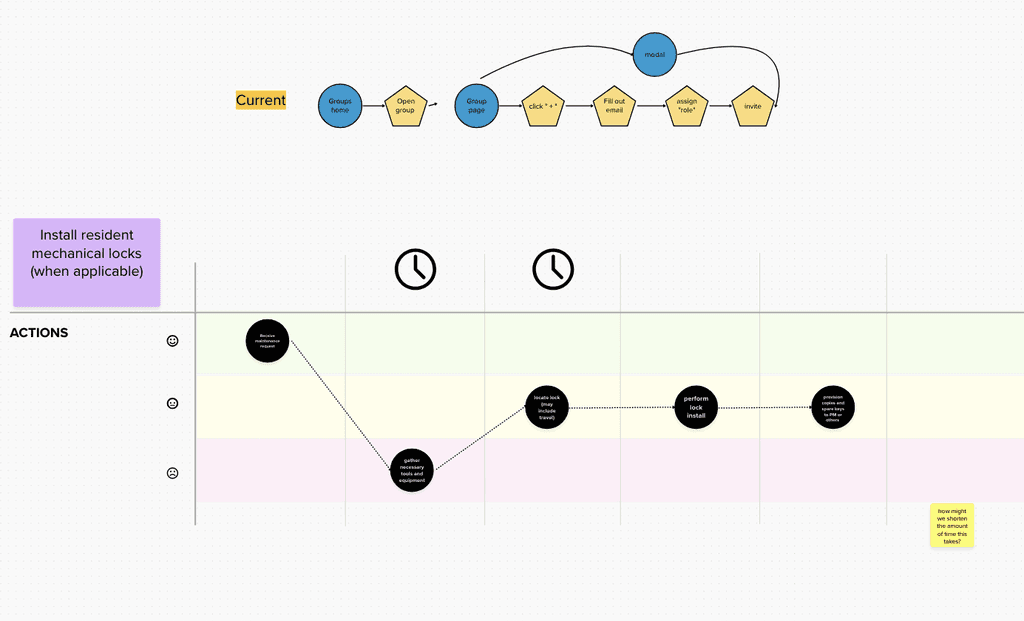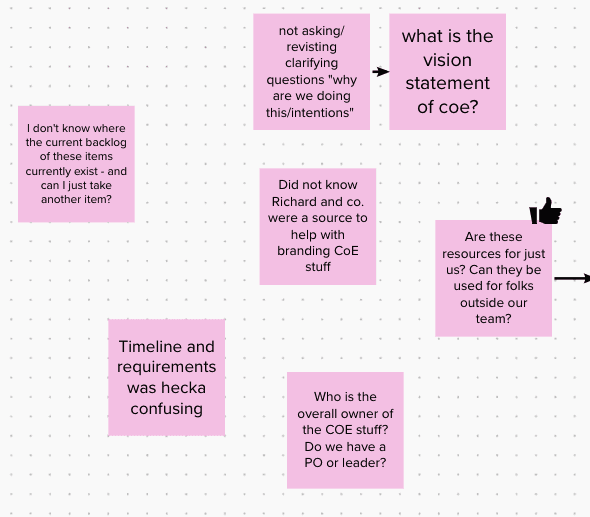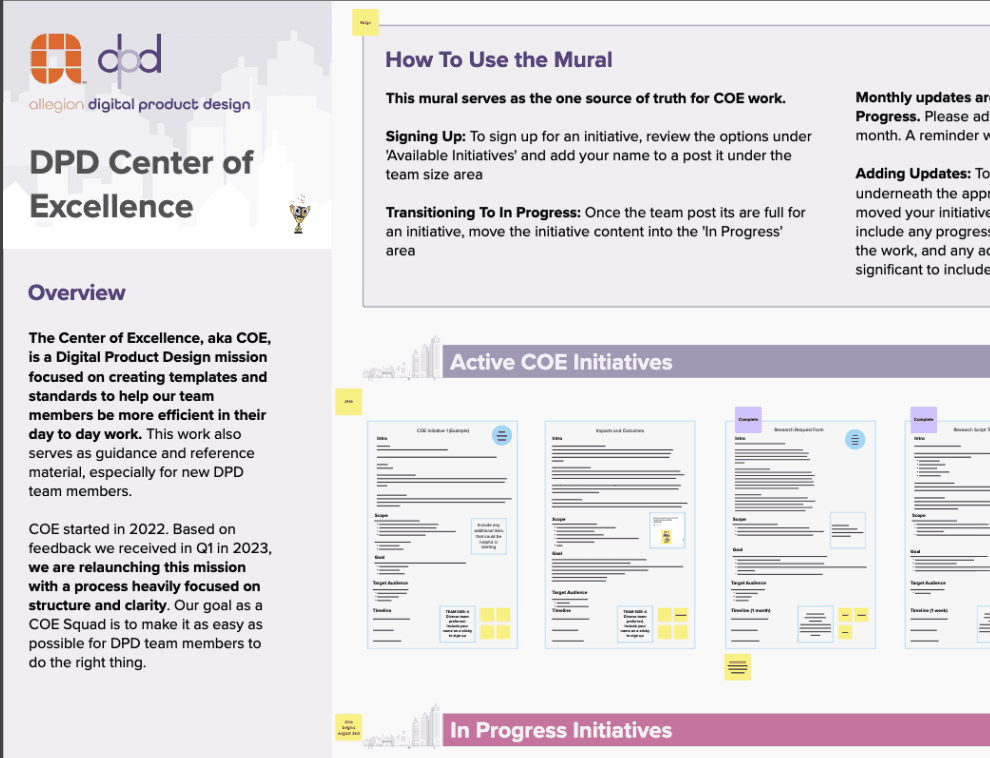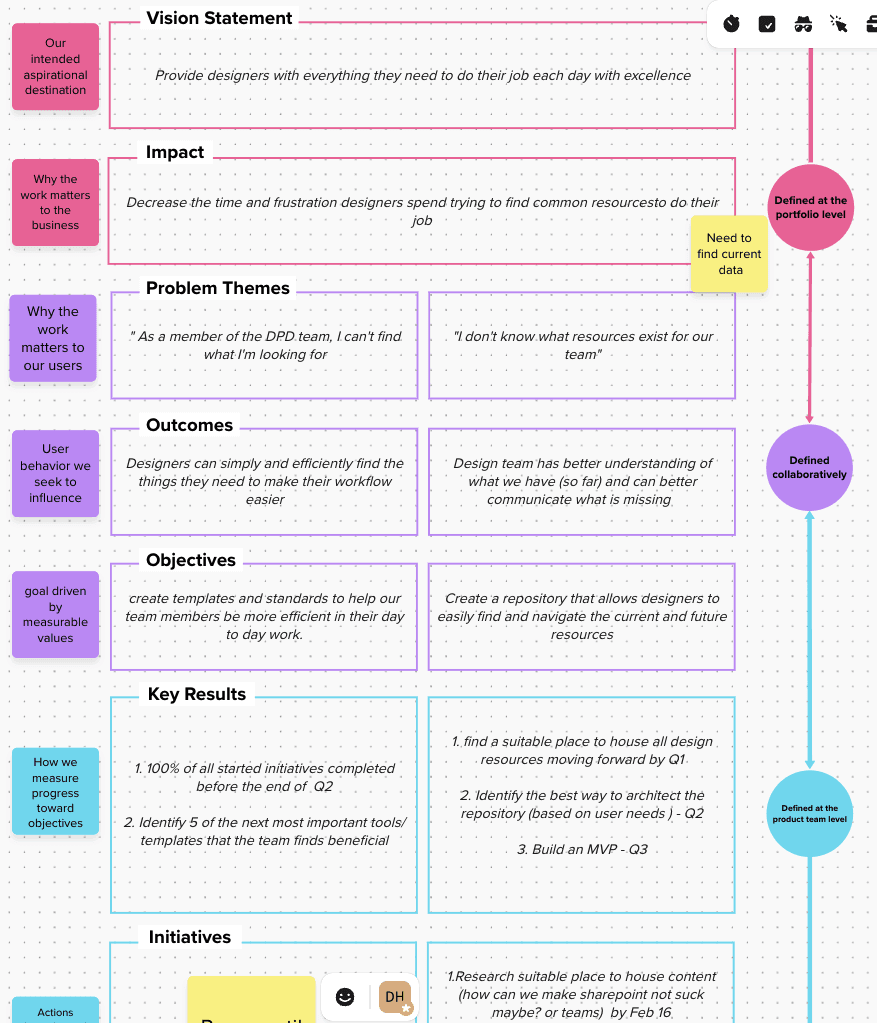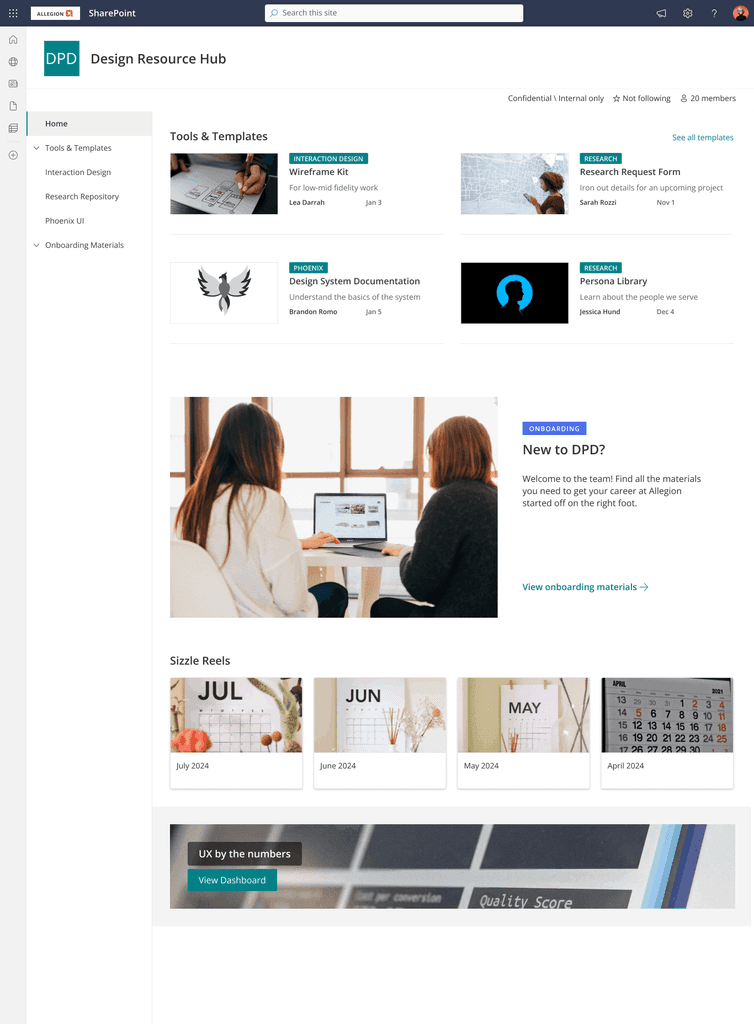Designing for Designers
Our design team failed twice while trying to create a hub for our shared resources and templates, but the third time is indeed the charm, and now I'm leading a steady march towards success.
Key Highlights
Goal
Improve the consistency and speed at which our team uses shared resources
Create the backbone for an onboarding process
Role(s)
Design Lead, Strategist
Deliverables
vision, strategy
Timeframe
Ongoing (2.5+ years)
Success Measurements
Improve the findability of shared resources
Reduce the amount of time spent creating already existing template items
Create consistency in the process/execution of design activities
OVerview
The Project
In 2022, our digital product design team set out on a mission: to improve the lives of our team members by creating templates and standards resulting in greater efficiency in the team's day-to-day work and more consistency in our shared artifacts with external teams.
Every designer & researcher of our 15 member team was a participant. At the start of this project, my role as a lead designer was to facilitate the completion of projects, and it was originated and lead by our design manager.
Here's a few examples:
design system related documents
starter templates for personas
library of existing personas
job aids for using problem statements + hypotheses
journey map templates
research script templates
team presentation slides
wireframing and prototyping best practices
So what's the value?
The value can be summarized in 3 words: efficiency, consistency, discoverability.
A sizeable chunk of the team's time was spent making and looking for common items they needed rather than just executing on the work. Through some a brief questionnaire, we discovered this took up about 3 hours per week. Many of our team members each had different versions of the aforementioned day to day items.
On the other hand, execution of tasks with those resources were inconsistent. An example being, at one point, we had 4 different persona templates, each with varying degrees of information captured. One of the core tenants of our team is to "do the right thing", and it became hard to do the right thing when everyone had a different idea of what the right thing was.
Lastly, even for the items we had, these were all de-centrally located. So you had to know someone who knew someone to get a hold of the "good presentation template".
Attempt 1
Defining top priority
Starting this project, we all felt great about our direction. As a team, we did an exercise to see what items people used on a daily/weekly basis to do their jobs, and affinity mapped to find common themes. Since our team is made up of Interaction, UI, and research designers, we had some similarities, but also many differences based on roles.
Furthermore as we scoped out what we commonly used, we had everyone share examples of the last time they used the item in question. To no surprise, everyone's was different.
With an list of items that we identified as most common, We split into teams of 2-3, items were randomly assigned, and we got to work on the items. Since this was kicked off around summer of '22 we gave loose timelines of October to have a completed project.
An example of 2 separate journey maps, capturing different levels of information
Check point (Q4 '22)
Fast forward 6 months, it's the end of the year. People had put in some work. Our lead team did a review of the items that were worked on. And as you might expect, the results, were not where we'd hoped they'd be.
3/7
items finished
We dug deeper into how the project was going. The design lead team did a retrospective with the entire team to understand more about how it went.
What the team said wasn't working
The feedback was primarily around a lack of structure, a definition of done, and finding time to do the work. And that was fair, designers are always asking for context, and we goofed by not doing that.
For some additional context around finding time, each one of us on the team supports a project team(s) within the company, and this additional workload was not to interfere with any superseding priorities for those teams.
Unclear what's ready and what's not
A symptom of the previous note, for the items that were completed and presumed ready for use, there was little or no communication that they could be used. To add insult to injury, team members were still making their own versions of ready made templates.
Attempt 2
New year, new me! (Q1 '23)
In preparation for our design team kick off, the design team made some changes and planned to present our soft re-boot of the project.
The changes
Added a council to oversee the project
Incentivized completion
Defined process and guidelines for the work items and a "definition of good"
Autonomy over project selection
Scheduled check-ins for accountability
(As a design lead, I was helping to doing the check ins)
Have you ever seen Groundhog day?
Once again, at the end of 3 months, we noticed the same problems persisted. Deadlines being pushed out, items at varied levels of completion, and a definite lack of motivation by the team to keep moving their individual projects along.
There was a lot of reflection after this second failure. We as a team had put a lot of time and effort into this venture, and despite our best efforts, this project was not where we'd presumed it would be. There were also plenty of moments of "is this a fruitless effort?"
And that's a fair question. We're essentially crowd funding design ops work within our team. That's a whole line of work in and of itself. Another retro later and we were still in the same position: everyone wants the value, but keeping things in momentum was a struggle.
So what's been the common denominator?
I gave this a lot of thought over a couple weeks. One day I had I heard an interesting quote in passing from another team lead. “I get what we’re doing, why it’s important and I want to help but even when it’s done I don’t know what happens with it.”
We spent so much time trying to create the items, we forgot that these things need to live somewhere.
Attempt 3
Flip it on it's head Q4 '22
Heading in 2024, I was asked to take over this initiative. I was asked specifically because I have a reputation for "flipping things on their head".
So I used one of my favorite tools, the strategy ladder to re-examine everything we had done up until this point. Strategy ladders are a way to visualize the connection between high level team aspirations to down ground-level features and initiatives. I took our original mission, intended impacts, and problems we were trying to solve and organized them in it, and by doing so, I discovered a huge gap in our approach.
We spent so much time trying to create the items, we forgot that these things need to go somewhere. And wherever they are, they needed to be easily navigable & discoverable.
Finding redemption Q1 '24
I really wanted buy in from the team on us making progress, on this initiative, and I know some were wary from having seen this thing fight for life multiple times now. I needed some WOW. So I created a visionary mock up to give context of what all these individual items were really destined for.
At our annual kick off I spent some time discussing this project, I acknowledged our past failures, and transitioned to what I saw as the missing piece to our future. This is what I presented.
Leaning into the future
I followed up the mockup with more in-depth walk-through of the strategy, and a few tweaks to the plan to keep this thing moving. For additional buy-in, I made clear the message that we're not going to ask them to put in more of their time for work, but rather their help define the things we still need. Afterall, we had stuff, we just needed to define how to best organize it. The reactions were a welcome surprise. After the presentation I had 4 non-lead designers reach out to partner, that's 1/5th of the team.
Next Steps
So where are things now?
We're still in progress
Currently, I'm working on creating the information architecture for our "site". We have an assumption that sharepoint will fit our needs, but before jumping into anything, we're doing a card sort to make sure the information architecture for our team is understood and organized. so far, we at least have these categories: Templates, Figma, Onboarding, Research, & Presentations
A picture is worth a thousand words
The importance of pieces to showcase a vision for projects cannot be understated enough. By providing a tangible, aspirational visual example of our long term goal, I was able to reinvigorate the excitement for this project and garner team engagement to pitch-in. Something we had been after this whole time.
If at first you don't succeed…
As the saying goes: try, try again. Our team fell on our face, big time. TWICE. We even doubted the value in what we we're trying to achieve. But we had data and feedback to guide us, which allowed us to more intelligently persevere,
We may have failed before, but we failed with intention. The key differentiator was shaking up and documenting the vision AND strategy instead of just the outcome, to give the team more context.
After all, we're designers, and what designer isn’t always after more context?


